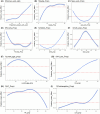Spatial disparities of antenatal care utilization among pregnant women in sub-Saharan Africa-Bayesian geo-additive modelling approach
- PMID: 40655215
- PMCID: PMC12247177
- DOI: 10.3389/fpubh.2025.1517724
Spatial disparities of antenatal care utilization among pregnant women in sub-Saharan Africa-Bayesian geo-additive modelling approach
Abstract
Background: Antenatal care (ANC) is critical for ensuring healthy pregnancies and positive birth outcomes. Despite its importance, significant disparities in ANC access and utilization exist across sub-Saharan Africa (SSA), influenced by various socioeconomic, geographical, and systemic factors. This study aimed to analyze the spatial disparities in the proportion of recommended ANC utilization and its associated risk factors among pregnant women in 34 sub-Saharan African countries.
Method: This study utilized the most recent Demographic and Health Survey (DHS) data from 34 countries across the SSA region. To assess the spatial disparities and their associated risk factors of ANC utilization, a geo-additive model via the Integrated Nested Laplace Approximation (INLA) was adopted.
Result: The overall prevalence of recommended ANC utilization in SSA was 22.15%, with a significant difference between countries, ranging from 0.27% in Rwanda to 76.28% in Zimbabwe. Both Moran's I and Geary's C tests, with different neighborhood structures, evidenced the existence of spatial autocorrelation of ANC utilization among women in SSA countries. A Bayesian geo-additive model with Besag-York-Mollié (BYM) mixed effect was found to be the best model to assess the spatial dependencies and the non-linear effects of the factors on ANC utilization among women of reproductive age. The study showed that the existence of spatial disparities in ANC utilization and media exposure, as well as the mother's work status, partner's working status, age of mother, age at first cohabitation, and place of delivery, has a significant effect on ANC utilization.
Conclusion: The overall coverage of recommended ANC in SSA countries falls short of the global minimum recommended ANC utilization. The lower coverage and inequality of ANC utilizations are influenced by underutilization of healthcare services, economic status, women's education coverage, poor/absence of transportation facilities, and media exposure related to healthy reproduction. Empowering women through different media outlets, strengthening their economic power, easy access to health facilities, and decision-making power increases maternal healthcare service utilization.
Keywords: INLA; antenatal care contacts; geo-additive; spatial disparities; sub-Saharan Africa.
Copyright © 2025 Belay, Fenta, Birhan, Rad and Chen.
Conflict of interest statement
The authors declare that the research was conducted in the absence of any commercial or financial relationships that could be construed as a potential conflict of interest.
Figures









Similar articles
-
Socio-economic and cultural factors associated with the utilization of maternal healthcare services in Togo: a cross-sectional study.Reprod Health. 2023 Jul 25;20(1):109. doi: 10.1186/s12978-023-01644-6. Reprod Health. 2023. PMID: 37488593 Free PMC article.
-
Individual and community level determinants of unmeet pregnancy complication education among pregnant ANC visitor women in Sub-Saharan Africa: a multilevel analysis of the recent demographic and health survey.BMC Pregnancy Childbirth. 2025 Jul 9;25(1):733. doi: 10.1186/s12884-025-07843-2. BMC Pregnancy Childbirth. 2025. PMID: 40634865 Free PMC article.
-
Influence of paternal education on maternal and child health outcomes in Sub-Saharan Africa: evidence from demographic and health surveys.Reprod Health. 2025 Jul 29;22(1):137. doi: 10.1186/s12978-025-02086-y. Reprod Health. 2025. PMID: 40730994 Free PMC article.
-
Utilization of maternal healthcare services in low- and middle-income countries: a systematic review and meta-analysis.Syst Rev. 2025 Apr 16;14(1):88. doi: 10.1186/s13643-025-02832-0. Syst Rev. 2025. PMID: 40241227 Free PMC article.
-
Health system and community level interventions for improving antenatal care coverage and health outcomes.Cochrane Database Syst Rev. 2015 Dec 1;2015(12):CD010994. doi: 10.1002/14651858.CD010994.pub2. Cochrane Database Syst Rev. 2015. PMID: 26621223 Free PMC article.
References
-
- Habte A, Tamene A, Melis T. Compliance towards WHO recommendations on antenatal care for a positive pregnancy experience: timeliness and adequacy of antenatal care visit in sub-Saharan African countries: evidence from the most recent standard demographic Health survey data. PLoS One. (2024) 19:e0294981. doi: 10.1371/journal.pone.0294981, PMID: - DOI - PMC - PubMed
-
- Aragaw FM, Alem AZ, Asratie MH, Chilot D, Belay DG. Spatial distribution of delayed initiation of antenatal care visits and associated factors among reproductive age women in Ethiopia: spatial and multilevel analysis of 2019 mini-demographic and health survey. BMJ Open. (2023) 13:e069095. doi: 10.1136/bmjopen-2022-069095, PMID: - DOI - PMC - PubMed
-
- Workie MS, Lakew AM. Bayesian count regression analysis for determinants of antenatal care service visits among pregnant women in Amhara regional state, Ethiopia. J Big Data. (2018) 5:1–23. doi: 10.1186/s40537-018-0117-8 - DOI
MeSH terms
LinkOut - more resources
Full Text Sources
Medical
Research Materials

